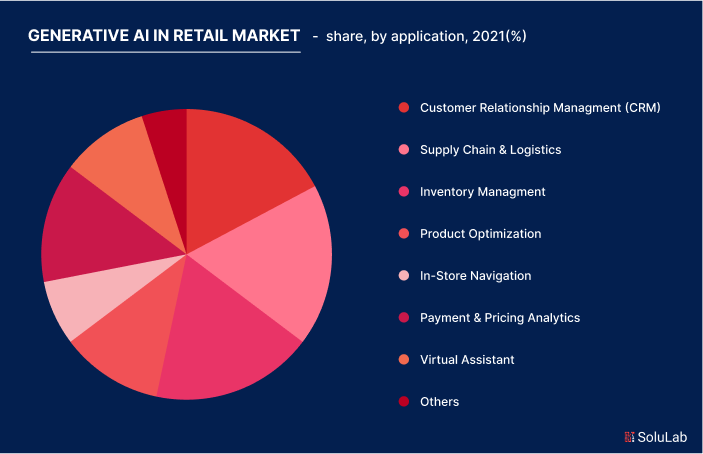The Transformative Power of Generative AI in Retail Industry
Generative Artificial Intelligence (Gen AI) is revolutionizing the retail industry by driving transformative changes across various aspects of the sector. Gen AI enhances customer experiences, optimizes operations, and offers strategic insights that help retailers stay competitive. Through machine learning, it generates new data, predicts trends, and refines processes. Retailers are now leveraging Gen AI to understand customer behavior, streamline supply chains, and anticipate market shifts, offering a competitive edge in an ever-changing landscape.






Adoption Rate
50%

Market Share
35%

Clients
750,000

Efficiency Increase
30%

Projected Saving
$1 trillion annually by 2030

Industry Overview
The retail industry, a key economic sector, is rapidly evolving due to technological advances, shifting consumer behaviors, and changing market trends. From physical stores to online platforms, retail adapts to a digital-first world. Innovations in AI, machine learning, and data analytics drive operational efficiency, while consumer demand for personalization, omni-channel experiences, and convenience shapes the future of retail.
Current Landscape
Generative AI is revolutionizing the retail industry by driving personalization, boosting operational efficiency, and enabling data-driven insights. Retailers use AI for personalized recommendations, dynamic content creation, and automated inventory management. AI-powered predictive analytics enhances demand forecasting and supply chain optimization, while AI-generated marketing ensures engaging and trend-driven content. With machine learning and big data analytics, AI helps retailers make strategic decisions, streamline operations, and improve the overall customer experience.

Industry Challenges
Data Privacy and Security

Challenge
Managing extensive amounts of sensitive customer data introduces significant privacy and security risks. With large volumes of personal information being collected, retailers face heightened risks of data breaches and unauthorized access.
Details
Adhering to stringent regulations like GDPR and CCPA is essential for compliance. These laws mandate rigorous data protection standards to ensure customer data is handled properly. Retailers must develop and implement robust data protection strategies to prevent unauthorized access and data breaches.
Protection
Effective protection involves advanced cybersecurity measures such as encryption, secure access controls, and regular security audits. These steps are crucial to safeguarding customer information and maintaining consumer trust.
Ethical Considerations

Challenge
AI systems can unintentionally perpetuate biases present in training data, potentially leading to unfair or discriminatory outcomes. If the training data reflects existing biases or lacks diversity, the AI models may produce skewed results that adversely affect certain groups of customers.

Bias Prevention
To combat these biases, it's crucial to utilize diverse and representative datasets. This approach helps in developing AI systems that reflect a broader range of customer experiences and demographics, aiming for more equitable outcomes.

Monitoring
Regular audits and continuous monitoring of AI models are necessary to detect and address biases. This ongoing oversight ensures that AI systems operate fairly and ethically, meeting societal standards and legal requirements.
Integration with Existing Systems

Challenge
Integrating advanced AI solutions with existing legacy systems can be complex and disruptive. Legacy systems often have outdated technology and incompatible architectures, making it challenging to incorporate new AI tools seamlessly.

Compatibility
Achieving a seamless integration requires meticulous planning and a thorough understanding of both the legacy systems and new AI technologies. Addressing compatibility issues is critical to prevent operational disruptions and ensure smooth functionality.

Adjustment
Retailers may need to make significant adjustments to their infrastructure, which could involve upgrading or modifying existing systems to support new AI technologies effectively.
High Implementation Costs
Challenge
The financial investment required for developing, deploying, and maintaining AI solutions can be considerable. Costs include not only the initial expenses for technology acquisition and development but also ongoing expenditures for system integration, staff training, and maintenance.

Investment
Initial costs include expenses for AI technology development, system integration, and staff training, which can be substantial. For smaller retailers, these upfront costs can be a significant barrier.

Budgeting
Additionally, ongoing maintenance and operational costs can strain budgets. Retailers must conduct detailed cost-benefit analyses and strategic financial planning to manage these expenses and ensure a positive return on investment.
Transparency and Explainability

Challenge
Many AI models operate as "black boxes," making it difficult to understand their decision-making processes. This lack of transparency can obscure how decisions are made, leading to challenges in validating and trusting the outcomes.

Understanding
Providing clear and detailed explanations of how AI models make decisions is crucial for building trust with customers and stakeholders. Transparency in AI operations helps users comprehend the rationale behind decisions and fosters confidence.
Accountability
Ensuring AI models are explainable supports accountability by aligning outputs with business goals and ethical standards. This transparency is essential for maintaining stakeholder trust and ensuring decisions are fair and justifiable.
Skill and Talent Shortages

Challenge
The scarcity of skilled AI professionals presents a significant challenge for retailers aiming to implement AI technologies effectively. Finding and retaining experts in artificial intelligence and machine learning is difficult due to high demand and competitive job markets.

Recruitment
Attracting and retaining talent in the competitive AI field can be challenging, impacting the ability to deploy and manage AI solutions successfully.
Training
Investing in training and development programs for existing employees can help bridge the talent gap. By enhancing the skills of current staff, retailers can build a knowledgeable team capable of supporting AI initiatives and driving technological innovation.
Need of Gen AI in Retail Industry

Personalized Shopping Experiences
Gen AI uses customer data to offer personalized product recommendations and tailored shopping experiences. By analyzing past purchases and browsing history, retailers can present relevant items, enhancing customer satisfaction and increasing sales.
Targeted Marketing Campaigns
AI-driven algorithms analyze customer behavior to create highly targeted marketing campaigns. This approach improves ad relevance, boosts engagement rates, and maximizes marketing ROI by reaching the right audience with personalized messages.


Dynamic Pricing Models
Gen AI enables dynamic pricing by analyzing market conditions, competitor prices, and demand fluctuations. Retailers can adjust prices in real time to optimize revenue and maintain competitiveness, ensuring pricing strategies are responsive and effective.
Inventory Optimization
AI forecasts demand more accurately, helping retailers manage inventory levels efficiently. By predicting sales trends and potential stockouts, retailers can reduce excess inventory, minimize waste, and ensure product availability.


Fraud Detection and Prevention
Gen AI identifies and prevents fraudulent transactions by analyzing transaction patterns and detecting anomalies. This capability enhances security, reduces financial losses, and builds trust with customers by safeguarding their financial information.
Automated Customer Service
AI-powered chatbots and virtual assistants handle customer inquiries, provide support, and resolve issues 24/7. This automation reduces response times, lowers operational costs, and improves overall customer service quality.


Enhanced Product Search
AI enhances product search functionalities by understanding natural language queries and recognizing visual search inputs. Customers can find products more easily, improving their shopping experience and increasing conversion rates.
Demand Forecasting
AI analyzes historical data and current trends to forecast future demand accurately. Retailers can use these forecasts to plan inventory, optimize supply chains, and align marketing efforts with expected sales volumes.


Personalized Content Creation
Gen AI uses customer data to offer personalized product recommendations and tailored shopping experiences. By analyzing past purchases and browsing history, retailers can present relevant items, enhancing customer satisfaction and increasing sales.
Use Cases of Gen AI in Retail Industry
Generative AI offers a range of transformative applications in the retail sector, enhancing various aspects from customer engagement to operational efficiency. Here’s a detailed look at some of the most impactful use cases:

Personalized Recommendations
Product Suggestions: By analyzing customer data such as past purchases, browsing history, and preferences, Gen AI algorithms can generate highly personalized product recommendations. For example, an AI system can suggest items that a customer is likely to be interested in based on their shopping behavior and similar customer profiles.
Dynamic Personalization: Gen AI can adapt recommendations in real time based on changing customer behavior. If a customer’s preferences shift during a shopping session, the AI can immediately adjust the recommendations to reflect their new interests.
Dynamic Content Generation
Marketing Copy: Gen AI can create engaging marketing content tailored to different customer segments. For instance, AI-generated copy can be customized for various demographics or geographies, ensuring that the messaging resonates with each audience.
Product Descriptions: Retailers can use Gen AI to automatically generate unique and compelling product descriptions. This not only speeds up the content creation process but also ensures that descriptions are optimized for search engines and customer engagement.
Social Media Posts: AI can craft personalized and timely social media content based on current trends, user interactions, and brand voice, helping retailers maintain a vibrant online presence and engage with their audience effectively.


Customer Service and Support
Virtual Assistants and Chatbots: AI-powered chatbots and virtual assistants can handle customer inquiries, process orders, and provide real-time support. These tools use natural language processing (NLP) to understand and respond to customer questions, improving service efficiency and availability.
Automated Issue Resolution: Gen AI can assist in resolving common customer issues by providing instant solutions based on historical data and frequently asked questions. This reduces the need for human intervention and accelerates problem resolution.
Inventory and Demand Management
Demand Forecasting: AI algorithms analyze historical sales data, market trends, and external factors to predict future demand for products. This helps retailers optimize inventory levels, reduce stockouts, and minimize excess inventory.
Stock Optimization: Gen AI can assist in managing stock levels by predicting the best times to reorder products and identifying slow-moving items. This improves inventory turnover and reduces carrying costs.


Supply Chain Optimization
Logistics and Routing: Gen AI can optimize delivery routes and logistics operations by analyzing factors such as traffic conditions, weather, and delivery schedules. This reduces transportation costs and improves delivery efficiency.
Supplier Management: AI can assess supplier performance and predict potential disruptions in the supply chain. This helps retailers manage relationships with suppliers more effectively and ensure a steady flow of goods.
Customer Insights and Behavior Analysis
Behavioral Analytics: Gen AI can analyze customer interactions and behaviors to uncover insights into preferences, buying patterns, and sentiment. This information helps retailers tailor their offerings and marketing strategies to better meet customer needs.
Sentiment Analysis: By analyzing customer reviews, social media posts, and feedback, AI can gauge customer sentiment and identify areas for improvement. This enables retailers to address concerns and enhance their overall customer experience.


Product Development and Innovation
Trend Analysis: Gen AI can identify emerging trends and consumer preferences by analyzing data from various sources, including social media and market research. This helps retailers stay ahead of market trends and develop innovative products that meet customer demand.
Design Generation: AI can assist in creating new product designs and variations based on current trends and customer preferences. For example, AI can generate fashion designs or product prototypes that align with emerging styles and consumer tastes.
Visual Merchandising
Virtual Try-Ons: Gen AI can enable virtual try-ons for products such as clothing, accessories, and cosmetics. Customers can use augmented reality (AR) to see how products would look on them before making a purchase, enhancing the shopping experience.
Visual Content Creation: AI can generate high-quality images and videos for product displays and marketing campaigns. This includes creating virtual storefronts, product mock-ups, and promotional visuals that attract and engage customers.


Price Optimization
Dynamic Pricing: Gen AI can analyze market conditions, competitor pricing, and customer behavior to optimize pricing strategies. This allows retailers to adjust prices in real time to maximize revenue and stay competitive.
Promotional Strategies: AI can generate personalized discounts and promotions based on customer data and purchasing patterns. This helps retailers design targeted offers that drive sales and enhance customer loyalty.
Fraud Detection and Prevention
Anomaly Detection: Gen AI can identify unusual patterns and behaviors that may indicate fraudulent activity. By analyzing transaction data and customer behavior, AI can help prevent fraud and protect both retailers and customers.
Risk Assessment: AI can assess the risk associated with transactions, such as high-value purchases or unusual purchase patterns. This enables retailers to take proactive measures to mitigate potential fraud risks.

Benefits of Gen AI in Retail Industry
Hyper-Personalization
Tailored Customer Experiences
Gen AI analyzes individual customer behavior, preferences, and purchase history to deliver highly personalized product recommendations and marketing messages. This deep level of personalization boosts customer satisfaction and loyalty, as shoppers feel valued with offerings that resonate with their unique tastes.

Increased Engagement
Personalized promotions and recommendations lead to more frequent interactions, creating a strong sense of connection with the brand. This heightened engagement helps to improve conversion rates and retention, making customers more likely to return for future purchases.
Enhanced Operational Efficiency
Optimized Inventory Management
Gen AI’s predictive analytics helps retailers forecast demand accurately, reducing the risk of stockouts or excess inventory. This optimization improves cash flow, minimizes waste, and ensures the right products are available when customers need them, enhancing operational efficiency.

Automation of Repetitive Tasks
Tasks such as product description generation, stock management, and customer support inquiries can be automated with AI. This frees up employees to focus on more strategic activities while reducing errors and speeding up operations.
Advanced Customer Service

24/7 Support with AI Assistants
AI-powered chatbots and virtual assistants provide round-the-clock customer support, answering inquiries, processing orders, and resolving issues without human intervention. This constant availability improves customer satisfaction and provides a seamless service experience.

Quick Issue Resolution
AI systems can instantly handle common customer issues, reducing wait times and ensuring faster resolutions. This leads to higher satisfaction and encourages repeat business.
Data-Driven Marketing Strategies

Targeted Marketing Campaigns
AI enables retailers to segment their audience and deliver highly targeted marketing campaigns based on real-time customer data. This results in more relevant ads, higher conversion rates, and better ROI on marketing efforts.
Dynamic Content Creation
AI-driven content generation tools create engaging marketing materials, from product descriptions to social media posts, ensuring fresh and relevant content that aligns with customer interests.
Optimized Supply Chain Management
Logistics and Route Optimization
Gen AI improves logistics by optimizing delivery routes and predicting potential supply chain disruptions. This leads to faster, more efficient deliveries and reduced transportation costs, ensuring customers receive their products on time.

Supplier and Risk Management
AI helps retailers monitor supplier performance, predict potential risks, and optimize procurement processes. This improves supply chain resilience and allows retailers to avoid costly disruptions.
Future Trends in Generative AI for Retail
Hyper-Personalization
Context-Aware Recommendations: Generative AI enhances personalization by analyzing contextual data like location, time of day, and customer preferences, delivering highly relevant product suggestions. This level of hyper-personalization makes shopping experiences more engaging and tailored, driving higher customer satisfaction and long-term loyalty.
Emotion Recognition: Advanced AI can detect customers' emotional states through facial expressions, voice tone, or online behavior. By adjusting product recommendations and marketing messages based on these emotional cues, AI strengthens emotional bonds between brands and customers, fostering deeper engagement and personalized experiences.
Advanced Conversational AI
Natural and Human-Like Interactions: Future conversational AI will be able to handle complex customer inquiries with greater empathy, improving the overall quality of virtual interactions. AI chatbots and virtual assistants will offer more human-like conversations, leading to better customer service experiences and faster issue resolution.
Voice Commerce: As voice technology advances, voice-enabled AI assistants will allow customers to make purchases using simple voice commands. This form of voice commerce will offer a hands-free, convenient shopping experience, revolutionizing how customers interact with e-commerce platforms and making shopping more accessible.AI-Driven Augmented Reality (AR)
Enhanced Virtual Try-Ons: Generative AI, combined with AR, will enable customers to virtually try on products like clothing, accessories, or makeup in real time. This immersive technology will bridge the gap between physical and digital retail experiences, helping customers make more informed purchasing decisions and reducing the likelihood of returns.
Interactive Shopping Experiences: AI-enhanced AR will create engaging virtual shopping environments where customers can explore 3D digital stores, interact with products, and even visualize how items fit into their lifestyles. This interactive experience will make online shopping more immersive and foster stronger customer engagement.Predictive and Adaptive Supply Chain Management
Dynamic Supply Chain Optimization: Generative AI’s predictive analytics will enable retailers to forecast demand with greater accuracy, allowing them to optimize inventory and prevent stockouts or overstock situations. By dynamically adjusting to real-time market trends and customer needs, retailers can improve supply chain agility and ensure better resource utilization.
Autonomous Logistics: AI-powered autonomous logistics, such as self-driving delivery vehicles and drones, will significantly enhance supply chain operations. These technologies will reduce delivery times, improve efficiency, and lower operational costs, allowing retailers to offer faster, more reliable shipping solutions.Embracing the Future: Generative AI's Transformative Impact on Retail
The integration of Generative AI in retail is poised to revolutionize the industry by enhancing customer engagement and streamlining operations. Through personalized shopping experiences and customized marketing, retailers can increase customer loyalty and satisfaction. Gen AI also optimizes key processes like inventory management, demand forecasting, and supply chain logistics, reducing costs and boosting efficiency. Looking ahead, trends such as AI-driven content creation and advanced predictive analytics will further elevate the retail sector. However, addressing data privacy and ethical concerns will be crucial for maximizing its potential and fostering sustainable growth.

Latest Blogs
How to build an MVP using Blockchain or Generative AI?
Learn how to build an MVP with GenAI or blockchain. Discover key steps, best practices, and tools to launch a scalable, cost-effective minimum viable product with both.
Read MoreGenerative AI in Accounting: 10 Use Cases & Examples
Discover how Generative AI is streamlining accounting processes, from auditing to financial forecasting, saving time and boosting business efficiency.
Read MoreThe Benefits of Generative AI in Creating Unique Game Assets
How is generative AI reshaping online casino game development? Discover how AI is transforming visuals, gameplay, and personalization in unexpected ways.
Read More



